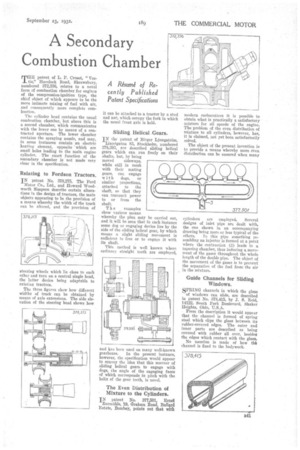A Secondary Combustion Chamber
Page 59

If you've noticed an error in this article please click here to report it so we can fix it.
A Ristuni of Recently Published Patent Specifications
THEpatent of L. P. Croset, " Vectis," Havelock Road, Shrewsbury, numbered 372,356, relates to a novel form of combustion chamber for engines of the compression-ignition type, the chief object of which appears to be the more intimate mixing of fuel with air, and consequently more complete combustion.
The cylinder head contains the usual combustion chamber, but above this is a second chamber, which communicates 'with the lower one by means of a contracted aperture. The lower chamber contains the spraying nozzle, and may, in some instances contain an electric heating element, opposite which are small holes leading to the main engine cylinder. The exact function of the secondary chamber is not made very clear in the specification.
Relating to Fordson Tractors.
IN patent No. 378,275, The Ford Motor Co., Ltd., and Howard Woodworth Simpson describe certain alterations in the design of tractors, the main objects appearing to be tbe provision of a means whereby the width of the track can he altered, and the provision of steering wheels which lie close to each other and turn on a central single head, the latter device being adaptable to existing tractors.
The three figures show how different widths of track can be obtained by means of axle extensions. The side elevation of the steering head shows how it can be attached to a tractor by a stud and nut, which occupy the fork in which the usual front axle is held.
Sliding Helical _Gears.
IN the patent of Birger Ljungstr5m, Linnegatan 83, Stockholm, numbered 378,393, are described sliding helical gears which can run freely on their shafts, but, by being
moved sideways, while still in mesh with their mating gears, can engage with dogs, or similar projections, attached to the shaft, so that they can transmit power to or from the shaft.
The The
examples show various means whereby the plan may be carried out, and it will be seen that in each instance some dog or engaging device lies by the side of the sliding helical gear, by which means a slight sliding movement is sufficient to free or to engage it with its shaft.
This method is well known where ordinary straight teeth are employed, and has been used on many well-known gearboxes. In the present instance, however, the specification would appear to convey the idea that this manner of sliding helical gears to engage with dogs, the angle of the engaging faces of which corresponds in pitch with the helix of the gear teeth, is novel.
The Even Distribution of Mixture to the Cylinders.
IN patent No. 377,501, Erna Zurmiihle, 19, GrahamRoad, BallAird Estate, Bombay, points out that with
modern carburetters it is possible to obtain what is practically a satisfactory mixture for all speeds of the engine. The problem of the even distribution of mixture to all cylinders, however, has, it is claimed, not yet been satisfactorily solved.
The object of the present invention is to provide a means whereby more even distribution can be ensured when many cylinders are employed. Several designs of inlet pipe are dealt with, the one shown in an accompanying drawing being more or less typical of the
others. In this pipe something resembling an injector is formed at a point where the contraction (3) leads to a tapering chamber, thus inducing a, movement of the gases throughout the whole length of the double pipe. The object of the movement of the gases is to prevent the separation of the fuel from the air in the mixture.
Guide Channels for Sliding Windows.
SPRING channels in which the glass
of windows can slide, are described in patent No. 378,415, by J. S. Reid, 14122, South Park Boulevard, Shaker Heights, Ohio, U.S.A.
From the description it would appear that the channel is formed of spring steel which clips the glass between its rubber-covered edges. The outer and inner parts are described as being covered with rubber all over, besides the edges which contact with the glass.
No mention is made of how thil channel is fixed to the bodywork.






































































































